Riccardo Gabriele of PR Communicare Vino, an Italian PR agency, represents some of the top Italian wineries. He asked me if I would like to meet with one of his new Italian producers for lunch in NYC, Mike Costanzo of Briganti Wines. Mike is an American and has a winery in Abruzzo. What Riccardo did not mention was that Mike was a former MLB third baseman and played for the Cincinnati Reds. I have met a lot of winery owners over the years from all over the world, but Mike’s association with baseball was a first.
 We met at Fresca by Scotto for lunch with Mike and his girlfriend Lauren.
We met at Fresca by Scotto for lunch with Mike and his girlfriend Lauren.
Mike is very personable and charming and we hit it off right away. We talked mostly about wine and food and a little about baseball.
Mike said Briganti is a brand that emerged from the well-respected Risogna Vini, an agricultural company located in Orsogna, Chieti, that has been producing high quality wines in the Abruzzo Region since 2017.
 The Abruzzo Region of Italy, located to the east of Rome, has everything going for it. There are beautiful national parks, a long coastline on the Adriatic, the rugged snowcapped Apennine Mountains, and little medieval towns perched precariously on hill tops. Abruzzo is situated between the Adriatic Sea and the Gran Sasso and Majella massif. It is one of the most unspoiled regions of Italy with three national parks and more than ten national and regional natural reserves. Abruzzo geographically is more central than southern Italy, but due to its connection with the old Kingdom of the Two Sicilies, it is considered part of the South. Most vineyards are in hilly areas, of which 75% are in the province of Chieti.
The Abruzzo Region of Italy, located to the east of Rome, has everything going for it. There are beautiful national parks, a long coastline on the Adriatic, the rugged snowcapped Apennine Mountains, and little medieval towns perched precariously on hill tops. Abruzzo is situated between the Adriatic Sea and the Gran Sasso and Majella massif. It is one of the most unspoiled regions of Italy with three national parks and more than ten national and regional natural reserves. Abruzzo geographically is more central than southern Italy, but due to its connection with the old Kingdom of the Two Sicilies, it is considered part of the South. Most vineyards are in hilly areas, of which 75% are in the province of Chieti.
Mike said the name Briganti pays homage to the region’s past, as Abruzzo is famous for being the birthplace of the brigandage movement in Italy. During the decade between 1860 and 1870 following Italy’s unification, the Briganti d’Abruzzo experienced its greatest development. Unification had the immediate effect of creating a huge increase in taxes that generated hunger, famine and widespread poverty. In response to a series of injustices, appropriations and violations, local people formed gangs to rebel against what was happening and fight for their rights. The gangs became roving bands that were known as brigantine.
Mike honors the memory of these brigantini with the names and pictures on the labels of the wine.
 Terre di Chieti IGP “Mecola” made from 100% made from 100% Pecorino. There are 1,600 plants per hectare. The training system is pergola and guyot (4,000 vines per hectare for the double guyot). Harvest takes place in October. Carefully selected grapes are destemmed then cry-maceration of the crushed grapes takes place for extraction of color and flavor. This is followed by a soft pressing of the grapes and temperature controlled fermentation in stainless steel tanks for 30 days. The wine has hints of lemon blossom, peach a hint of jasmine, floral notes of acacia and a slight mineral edge.
Terre di Chieti IGP “Mecola” made from 100% made from 100% Pecorino. There are 1,600 plants per hectare. The training system is pergola and guyot (4,000 vines per hectare for the double guyot). Harvest takes place in October. Carefully selected grapes are destemmed then cry-maceration of the crushed grapes takes place for extraction of color and flavor. This is followed by a soft pressing of the grapes and temperature controlled fermentation in stainless steel tanks for 30 days. The wine has hints of lemon blossom, peach a hint of jasmine, floral notes of acacia and a slight mineral edge.
Mike said Pecorino is one of Italy’s indigenous grape varieties cultivated in the hills of Abruzzo. It is known for its refreshing acidity, floral aromas, stone fruits, tropical fruit flavors and minerality. Mike said that the wine is named for Mecola, an Abruzzese ancestor who proudly defended the freedoms of the farmers of Abruzzo in the 1860s during the unification of Italy.
 Terre Di Chieti IGP Pinot Grigio “Filomena D’Orazio” made from 100% Pinot Grigio. There are 4,000 wines per hectare and the training system is guyot. Harvest is at the end of August. Carefully selected grapes are soft pressed and fermentation is in temperature controlled stainless steel for 10/15 days. The wine remains in stainless steel until it is bottled. The wine has hints of citrus fruit, chestnut, a touch of honey and a note of hazelnuts.
Terre Di Chieti IGP Pinot Grigio “Filomena D’Orazio” made from 100% Pinot Grigio. There are 4,000 wines per hectare and the training system is guyot. Harvest is at the end of August. Carefully selected grapes are soft pressed and fermentation is in temperature controlled stainless steel for 10/15 days. The wine remains in stainless steel until it is bottled. The wine has hints of citrus fruit, chestnut, a touch of honey and a note of hazelnuts.
Mike said that his winemaking philosophy reflects the passion of those who fought against oppression and sought refuge in cultivating the land. This wine celebrates Filomena D’Orazio, who represents the strength and courage of her time. This is their signature Pinot Grigio.
 Cerasuolo D’Abruzzo DOC “Ciuccolo” this rosé is made from 100% Montepulciano d’Abruzzo. There are 1,400 vines per hectare and they are pergola trained. Harvest is in the first 10 days of October. The grapes are crushed with maceration on the skins for 2/4. Then a soft pressing followed by a cold soak clarification. Fermentation is in stainless steel at a controlled temperature for 10/12 days. The wine remains in stainless steel until it is ready to bottle. The wine has hints of strawberries, pomegranate, and cherry and it is medium bodied with crisp acidity.
Cerasuolo D’Abruzzo DOC “Ciuccolo” this rosé is made from 100% Montepulciano d’Abruzzo. There are 1,400 vines per hectare and they are pergola trained. Harvest is in the first 10 days of October. The grapes are crushed with maceration on the skins for 2/4. Then a soft pressing followed by a cold soak clarification. Fermentation is in stainless steel at a controlled temperature for 10/12 days. The wine remains in stainless steel until it is ready to bottle. The wine has hints of strawberries, pomegranate, and cherry and it is medium bodied with crisp acidity.
Mike said Cerasuolo d’Abruzzo is a hearty, robust rosé, with rich color and fresh fruit flavors. It has stood the test of time. This wine is named in honor of the brigand known as “Ciuccolo” who fought for the rights of his fellow citizens during the unification of Italy in the 1860’s. His legend lives on and is timeless.
 Montepulciano D’Abruzzo DOC “Ninco Nanco” made from 100% Montepulciano D’Abruzzo. There are 1,600 vines per hectare and the training system is pergola and guyot. The grapes are hard harvested in October. At the winery the grapes are destemmed, crushed and transferred to fermentation tanks. There is daily pumping over for iteration of color and tannins. After fermentation is done the wine goes into concrete tanks and malolactic fermentation is completed in 7/10 days. The wine remains in concrete until it is ready to bottle. The wine has hints of black cherry, raspberry, red plum, hint of tobacco and a touch of spice.
Montepulciano D’Abruzzo DOC “Ninco Nanco” made from 100% Montepulciano D’Abruzzo. There are 1,600 vines per hectare and the training system is pergola and guyot. The grapes are hard harvested in October. At the winery the grapes are destemmed, crushed and transferred to fermentation tanks. There is daily pumping over for iteration of color and tannins. After fermentation is done the wine goes into concrete tanks and malolactic fermentation is completed in 7/10 days. The wine remains in concrete until it is ready to bottle. The wine has hints of black cherry, raspberry, red plum, hint of tobacco and a touch of spice.
Mike said that this wine is in named honor of Ninco Nanco, a dedicated patriot of Italy’s independence and a believer in social justice, who represents the power and strength of the red wines from Abruzzo. Montepulciano is rich and bold with natural acidity, ripe red/black fruits, and robust herbal and spicy notes.
 The wine was a perfect combination with the pork and red peppers we had for lunch.
The wine was a perfect combination with the pork and red peppers we had for lunch.
After tasting the wines I asked Mike what the retail price would be, and he said between $16 and $18 a bottle. These wines are a fantastic value for the money.
Mike is looking for a distributor in the NY and his wines are available in other parts of the US.
As a lifelong baseball fan, I asked Mike about his career in the Major Leagues. We talked a lot about it and Mike said that one of the highlights of his career was at Yankee Stadium where he got his first major hit. Derek Jeter, the great Yankee shortstop, retrieved the ball and gave it to him. He will never forget that moment and meeting Jeter.


 I was invited by the organizer of the event and the speaker, Susannah Gold. I have been to a number of events hosted by her and they are all well organized and informative.
I was invited by the organizer of the event and the speaker, Susannah Gold. I have been to a number of events hosted by her and they are all well organized and informative.
 Trebbiano D’Abruzzo DOC 2021 Nic Tartaglia made from 100% made from 100% Trebbiano d’Abruzzo from 41 year old vines at 303 meters. The training system is the pergola and there are 1,600 vines per hectare. Harvest takes place at the end of September. The grapes are soft pressed, followed by static clarification. Fermentation is in temperature controlled stainless steel vats for 30 days. Malolactic fermentation does not take place. Aging is in stainless steel vats. The wine is bottled in the spring following the harvest. The wine has hints of citrus fruit, lemon, lime and almonds in the finish.
Trebbiano D’Abruzzo DOC 2021 Nic Tartaglia made from 100% made from 100% Trebbiano d’Abruzzo from 41 year old vines at 303 meters. The training system is the pergola and there are 1,600 vines per hectare. Harvest takes place at the end of September. The grapes are soft pressed, followed by static clarification. Fermentation is in temperature controlled stainless steel vats for 30 days. Malolactic fermentation does not take place. Aging is in stainless steel vats. The wine is bottled in the spring following the harvest. The wine has hints of citrus fruit, lemon, lime and almonds in the finish. Pecorino Superiore Abruzzo DOC 2021 “la Canaglia” (Nic Tartaglia is the owner) Azienda Agricola Fontefico made from 100% Pecorino from a vineyard at 120 meters. The training system is guyot and there are 4,000 plants per hectare with an eastern exposure. The soil is iron, sand and clay. It is a single vineyard wine and is estate bottled and the farm is organic. This is a full bodied, crisp white wine with high minerality and hints of grapefruit, sage, and white flowers with a touch of almonds. It is called La Canaglia, the rascal, of Fontefico because the yields are very low. There is a different label on the bottle very year because every wine has its own personality.
Pecorino Superiore Abruzzo DOC 2021 “la Canaglia” (Nic Tartaglia is the owner) Azienda Agricola Fontefico made from 100% Pecorino from a vineyard at 120 meters. The training system is guyot and there are 4,000 plants per hectare with an eastern exposure. The soil is iron, sand and clay. It is a single vineyard wine and is estate bottled and the farm is organic. This is a full bodied, crisp white wine with high minerality and hints of grapefruit, sage, and white flowers with a touch of almonds. It is called La Canaglia, the rascal, of Fontefico because the yields are very low. There is a different label on the bottle very year because every wine has its own personality. Cerasuolo D’Abruzzo
Cerasuolo D’Abruzzo Montepulciano D’Abruzzo 2017 Riserva “Villa Gemma” Masciarelli made from 100% Montepulciano d’Abruzzo on steep, sloped Colle Cave vineyards in Chieti. The soil is limestone, clay and gravel. The training system is French guyot and the farming is sustainable. Harvest is by hand. The harvest ended in October. Fermentation is in stainless steel 15 to 20 days, followed by a maceration of 23 to 30 days.
Montepulciano D’Abruzzo 2017 Riserva “Villa Gemma” Masciarelli made from 100% Montepulciano d’Abruzzo on steep, sloped Colle Cave vineyards in Chieti. The soil is limestone, clay and gravel. The training system is French guyot and the farming is sustainable. Harvest is by hand. The harvest ended in October. Fermentation is in stainless steel 15 to 20 days, followed by a maceration of 23 to 30 days. Château De Gardes “Cuvée Fût de Chêne” AOC Cadillac 2019 made from 100% Sémillon from 60 year old vines on 64 hectares. The training system is guyot. Harvest is by hand and there are several sortings of the grapes. Traditional winemaking using pneumatic press and gentle filtration before bottling. The wine is aged for 12 months in oak barrels. There is a good balance between sugar and alcohol, with hints of candied fruit and vanilla. The wine can age for 20 years.
Château De Gardes “Cuvée Fût de Chêne” AOC Cadillac 2019 made from 100% Sémillon from 60 year old vines on 64 hectares. The training system is guyot. Harvest is by hand and there are several sortings of the grapes. Traditional winemaking using pneumatic press and gentle filtration before bottling. The wine is aged for 12 months in oak barrels. There is a good balance between sugar and alcohol, with hints of candied fruit and vanilla. The wine can age for 20 years.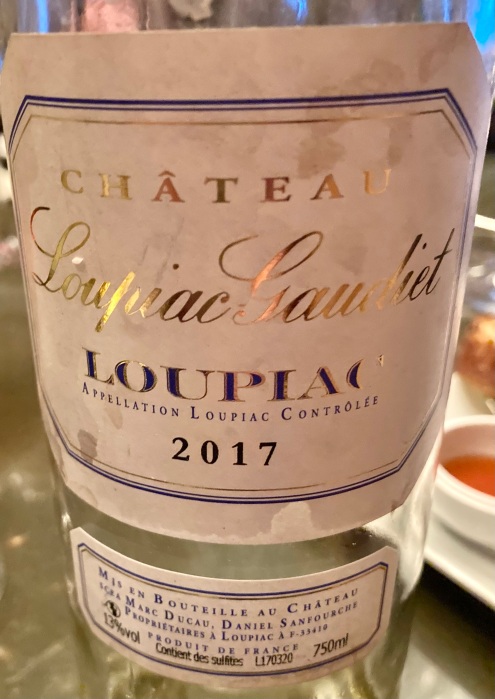 Château Loupiac-Gaudiet AOC Loupiac 2017 made from 90 % Sémillion and 10% Sauvignon from 45 year old vines on 26 hectares. The soil is clay and limestone and the pruning system is simple guyot. Harvest is by hand as soon as the botrytis appears.Traditional winemaking using modern methods–pneumatic press and temperature controlled fermentation. Drink it 2 to 5 years if you want it fresh and fruity, or 5 to ten years if you prefer more richness, or 10 to 30 if you prefer more smoothness. The wine has a good balance between fruit sugar and acidity. There are hints of honey, beeswax, dried stone fruit, lemon, marmalade and a touch of spice in the finish. I was very impressed with this wine.
Château Loupiac-Gaudiet AOC Loupiac 2017 made from 90 % Sémillion and 10% Sauvignon from 45 year old vines on 26 hectares. The soil is clay and limestone and the pruning system is simple guyot. Harvest is by hand as soon as the botrytis appears.Traditional winemaking using modern methods–pneumatic press and temperature controlled fermentation. Drink it 2 to 5 years if you want it fresh and fruity, or 5 to ten years if you prefer more richness, or 10 to 30 if you prefer more smoothness. The wine has a good balance between fruit sugar and acidity. There are hints of honey, beeswax, dried stone fruit, lemon, marmalade and a touch of spice in the finish. I was very impressed with this wine.
 The picture on the label is of a trabocco, a characteristic site in this part of Abruzzo. Fishermen traditionally built these wooden piers topped with a shed that jut far out from the shore from which to catch fish. Today some have been turned into restaurants. I had an excellent fish dinner at Trabocco Punta Cavalluccio and it was like eating on a boat, but without the waves.
The picture on the label is of a trabocco, a characteristic site in this part of Abruzzo. Fishermen traditionally built these wooden piers topped with a shed that jut far out from the shore from which to catch fish. Today some have been turned into restaurants. I had an excellent fish dinner at Trabocco Punta Cavalluccio and it was like eating on a boat, but without the waves.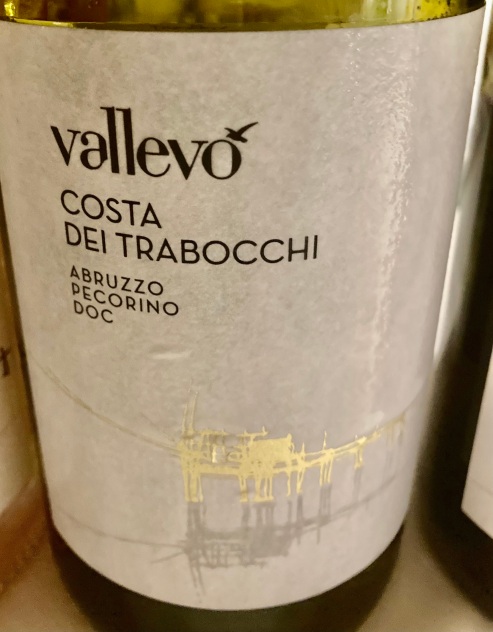 Costa Dei Trabocchi Abruzzo Pecorino made from 100% Pecorino from vineyards in the municipality of Rocco San Giovanni at 150 meters with a northern exposure.
Costa Dei Trabocchi Abruzzo Pecorino made from 100% Pecorino from vineyards in the municipality of Rocco San Giovanni at 150 meters with a northern exposure.  Costa Dei Trabocchi Rosato Terre Di Chieti IGT Made from 70% Montepulciano and 30% Merlot. The soil is of medium texture, with some clay and limestone. The vineyard is situated on hills overlooking the Trabocchi Coast with a northeast exposure at 150 to 200 meters. Vinification is with a Provencal technique without pressing in temperature controled stainless steel tanks. Skin contact is only for 3 hours but the wine remains on the lees for 2 weeks in steel tanks to capture the flavor of the grapes. The must is stirred for about one week at 5C. Fermentation is in steel tanks at a controlled temperature. Aging is in steel followed by a few months in bottle before release. The wine has hints of strawberries and raspberries a touch of grapefruit and a note of watermelon.
Costa Dei Trabocchi Rosato Terre Di Chieti IGT Made from 70% Montepulciano and 30% Merlot. The soil is of medium texture, with some clay and limestone. The vineyard is situated on hills overlooking the Trabocchi Coast with a northeast exposure at 150 to 200 meters. Vinification is with a Provencal technique without pressing in temperature controled stainless steel tanks. Skin contact is only for 3 hours but the wine remains on the lees for 2 weeks in steel tanks to capture the flavor of the grapes. The must is stirred for about one week at 5C. Fermentation is in steel tanks at a controlled temperature. Aging is in steel followed by a few months in bottle before release. The wine has hints of strawberries and raspberries a touch of grapefruit and a note of watermelon. Montepulciano D’Abruzzo DOC made from 100% Montepulciano d’Abruzzo. The soil is muddy clay. After pressing and destemming, fermentation is in stainless steel tanks at a controlled temperature for 7 to 10 days. Malolactic fermentation is in stainless steel. The wine is aged in stainless steel until it is ready to be bottled. This is a fruity, medium bodied wine with hints of plum, black cherry, and violets
Montepulciano D’Abruzzo DOC made from 100% Montepulciano d’Abruzzo. The soil is muddy clay. After pressing and destemming, fermentation is in stainless steel tanks at a controlled temperature for 7 to 10 days. Malolactic fermentation is in stainless steel. The wine is aged in stainless steel until it is ready to be bottled. This is a fruity, medium bodied wine with hints of plum, black cherry, and violets Costa Dei Trabocchi Montepulciano Dei Abruzzo DOC Riserva made from 100% Montepulciano from Rocco San Giovanni on the best-situated hills overlooking the Costa dei Trabocchi. The soil is medium texture, mostly clay and the vines are 10-15 years old. The exposure is south, southeast. The grapes are soft pressed and fermentation takes place in stainless steel with skin contact for 10 to 15 days depending on the vintage. The wine is aged in 500 liter barrels of Allier oak for about 14 months, then in steel, and finally in bottle until it is ready for release. This is a full bodied wine that has aromas and flavors of violets, plums and black cherry with a hint of vanilla.
Costa Dei Trabocchi Montepulciano Dei Abruzzo DOC Riserva made from 100% Montepulciano from Rocco San Giovanni on the best-situated hills overlooking the Costa dei Trabocchi. The soil is medium texture, mostly clay and the vines are 10-15 years old. The exposure is south, southeast. The grapes are soft pressed and fermentation takes place in stainless steel with skin contact for 10 to 15 days depending on the vintage. The wine is aged in 500 liter barrels of Allier oak for about 14 months, then in steel, and finally in bottle until it is ready for release. This is a full bodied wine that has aromas and flavors of violets, plums and black cherry with a hint of vanilla. I met Rodrigo when he was a wine salesperson in NYC. We talked about different people we knew and the wine business in NYC.
I met Rodrigo when he was a wine salesperson in NYC. We talked about different people we knew and the wine business in NYC. Pecorino Superiore Abruzzo “Trabocchetto”
Pecorino Superiore Abruzzo “Trabocchetto” Rodrigo said the link to the Abruzzo region, to its history, and our roots represents the basis for the selection of all the names of Talamonti wines. The term Trabocchetto was selected for its historical importance to the Abruzzo’s fishing tradition. According to local historians, the trabocco (or trabucco) was a fishing innovation imported from the Middle East with literature references dating back to the 18th Century. These ancient fishing machines were quickly adopted throughout the Adriatic Coast. Built exclusively out of wood, the construction permitted fisherman to fish in the worst of weather conditions. The trabocco is a wooden platform that stretches out to the sea and is anchored to large rocks. Long arms or antennas soar above and sustain an enormous net called “trabocchetto”. Today a few have been turned into restaurants.
Rodrigo said the link to the Abruzzo region, to its history, and our roots represents the basis for the selection of all the names of Talamonti wines. The term Trabocchetto was selected for its historical importance to the Abruzzo’s fishing tradition. According to local historians, the trabocco (or trabucco) was a fishing innovation imported from the Middle East with literature references dating back to the 18th Century. These ancient fishing machines were quickly adopted throughout the Adriatic Coast. Built exclusively out of wood, the construction permitted fisherman to fish in the worst of weather conditions. The trabocco is a wooden platform that stretches out to the sea and is anchored to large rocks. Long arms or antennas soar above and sustain an enormous net called “trabocchetto”. Today a few have been turned into restaurants. Trebbiano D’Abruzzo Riserva “Aternvm” made from 100% Trebbiano D’Abruzzo from Loreto Aprutino. The soil is limestone clay and the vineyard is at 300 meters. The training system is overhead trellis and the vines were planted in 1975-1980. Vinification is the same as the wine above. The wine is aged for several months in 300 liter French oak barrels (30%) and in stainless steel(70%) with repeated batonnages before the wine is bottled. The wine has hints of citrus fruit, lemon, lime and a touch of spice with a pleasant acidity. It is a wine that can age for a few years.
Trebbiano D’Abruzzo Riserva “Aternvm” made from 100% Trebbiano D’Abruzzo from Loreto Aprutino. The soil is limestone clay and the vineyard is at 300 meters. The training system is overhead trellis and the vines were planted in 1975-1980. Vinification is the same as the wine above. The wine is aged for several months in 300 liter French oak barrels (30%) and in stainless steel(70%) with repeated batonnages before the wine is bottled. The wine has hints of citrus fruit, lemon, lime and a touch of spice with a pleasant acidity. It is a wine that can age for a few years. Montepulciano D’Abruzzo Riserva “Tre Saggi” Selected vineyards located near the village of Loreto Aprutino in the Monrpulciano d’Abruzzo DOC zone. Made from 100% Montepulciano d’Abruzzo. The soil is stony calcareous and drained and the vineyard is at 300 meters. Harvest is by hand in mid-October. The grape stalks are removed. Alcoholic fermentation with skin contact takes place with selected yeasts during 14 days with periodic pumping over. Malolactic fermentation is in 300 liter French oak barrels (Allier and Troncais). Then the wine is aged for 12 months in 300 liter French oak barrels. The wine remains in bottle for 12 months before release. The wine has hints of violets, wild berries, blackberries, cherry, spice, a hint of hazelnut and a touch of coffee. This wine should age for at least 10 years.
Montepulciano D’Abruzzo Riserva “Tre Saggi” Selected vineyards located near the village of Loreto Aprutino in the Monrpulciano d’Abruzzo DOC zone. Made from 100% Montepulciano d’Abruzzo. The soil is stony calcareous and drained and the vineyard is at 300 meters. Harvest is by hand in mid-October. The grape stalks are removed. Alcoholic fermentation with skin contact takes place with selected yeasts during 14 days with periodic pumping over. Malolactic fermentation is in 300 liter French oak barrels (Allier and Troncais). Then the wine is aged for 12 months in 300 liter French oak barrels. The wine remains in bottle for 12 months before release. The wine has hints of violets, wild berries, blackberries, cherry, spice, a hint of hazelnut and a touch of coffee. This wine should age for at least 10 years. Rosso IGP Colin Pescaresi “Kudos” made from 80% Montepulciano and 20% Merlot. The soil
Rosso IGP Colin Pescaresi “Kudos” made from 80% Montepulciano and 20% Merlot. The soil The Charming Estates of Europe, a special project that links the flavors of wine from Italy and France and of fresh fruit from Greece and introduce them to the United States and Canada. The event was called The Charming Taste of Europe.
The Charming Estates of Europe, a special project that links the flavors of wine from Italy and France and of fresh fruit from Greece and introduce them to the United States and Canada. The event was called The Charming Taste of Europe. The organizer and speaker of the event was Susannah Gold and it was held at
The organizer and speaker of the event was Susannah Gold and it was held at  Pecorino Superiore 2020 Abruzzo DOC Poderi
Pecorino Superiore 2020 Abruzzo DOC Poderi Spaghetti alla Chitarra con Ragu di Maiale — We had homemade square spaghetti in a rich pork ragu, a local specialty.
Spaghetti alla Chitarra con Ragu di Maiale — We had homemade square spaghetti in a rich pork ragu, a local specialty. Trebbiano D’Abruzzo 2019 Riserva “Marina Cretic”
Trebbiano D’Abruzzo 2019 Riserva “Marina Cretic”  Cerasuolo
Cerasuolo Patate Maritate — Potatoes with cheese, sausage and herbs.
Patate Maritate — Potatoes with cheese, sausage and herbs. Montepulciano D’Abruzzo 2019 Francesco Cirelli (BIO) made from 100% Montepulciano The soil is clay and limestone and the training system is guyot. Harvest is at the end of September and the beginning of October. Harvest is manual. The grapes are destemmed and gently crushed and there is a 12 day maceration, spontaneous fermentation in amphora with indigenous yeasts. The wine is aged for 12 months in amphora. The wine has hints of red fruit, cherry and a touch of strawberry.
Montepulciano D’Abruzzo 2019 Francesco Cirelli (BIO) made from 100% Montepulciano The soil is clay and limestone and the training system is guyot. Harvest is at the end of September and the beginning of October. Harvest is manual. The grapes are destemmed and gently crushed and there is a 12 day maceration, spontaneous fermentation in amphora with indigenous yeasts. The wine is aged for 12 months in amphora. The wine has hints of red fruit, cherry and a touch of strawberry. Brodetto alla Vastese — Our next course was a variety of seafood in a flavorful sauce.
Brodetto alla Vastese — Our next course was a variety of seafood in a flavorful sauce. Montepulciano D’Abruzzo Riserva DOC 2017 “Ruberò”
Montepulciano D’Abruzzo Riserva DOC 2017 “Ruberò” Montepulciano D’Abruzzo Riserva 2015 “Casauria”
Montepulciano D’Abruzzo Riserva 2015 “Casauria”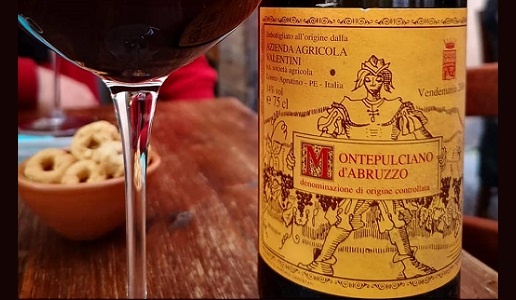
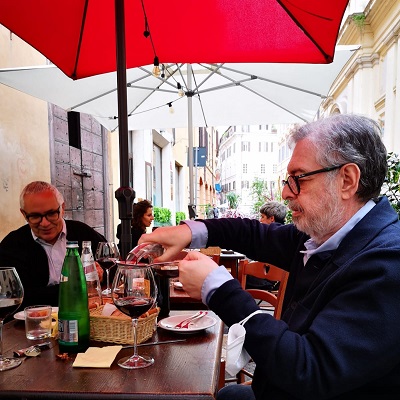 I
I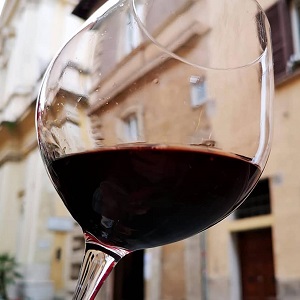 But it was through tasting the wine that we understood how it was on a different level than the other excellent wines we had sampled. The tannins were lively, distinct yet not aggressive. The right definition would be that they were “authentic”, grapey and with very little wood. Then there was that tad of carbonation, perhaps the product of the “remnants” of the initial malolactic fermentation in the bottle, which was so fine and composed it was hardly noticeable. This aspect may cause some rather orthodox tasters to turn up their noses but it had the same justification as Shakespearean poetic license had in obtaining the desired effect.
But it was through tasting the wine that we understood how it was on a different level than the other excellent wines we had sampled. The tannins were lively, distinct yet not aggressive. The right definition would be that they were “authentic”, grapey and with very little wood. Then there was that tad of carbonation, perhaps the product of the “remnants” of the initial malolactic fermentation in the bottle, which was so fine and composed it was hardly noticeable. This aspect may cause some rather orthodox tasters to turn up their noses but it had the same justification as Shakespearean poetic license had in obtaining the desired effect. Meursault-Perrieres 2010 Premier Cru Jean Latour Labille &Fils made from 100% Chardonnay from a .175-hectare parcel planted in 1964. Fermentation and aging are in barrels, 50% new for 12 months then 4 months of additional aging in tank. This is a complex wine with hints of citrus fruit, melon, pear, a touch of honey and a note of brioche. I visited the winery in 2019 and really enjoyed all their wines.
Meursault-Perrieres 2010 Premier Cru Jean Latour Labille &Fils made from 100% Chardonnay from a .175-hectare parcel planted in 1964. Fermentation and aging are in barrels, 50% new for 12 months then 4 months of additional aging in tank. This is a complex wine with hints of citrus fruit, melon, pear, a touch of honey and a note of brioche. I visited the winery in 2019 and really enjoyed all their wines. We had a few little Appetizers to go with the wine. Some Castelvetrano olives, a mushroom pate from Michele’s book,
We had a few little Appetizers to go with the wine. Some Castelvetrano olives, a mushroom pate from Michele’s book,  Irpinia Aglianico 2016 “Memini” Az. Ag. Guastaferro made from 100% Aglianico. This wine bursts with sweet ripe fruit flavors of cherry, raspberry, strawberry and pomegranate. It has a wonderful fruit filled finish and a very long aftertaste. It was a very interesting Aglianico and I have never tasted one like this before. Daniele Cernilli (aka Doctor Wine) in his book The Essential Guide to Italian Wine 2020 states: “In 2002 Raffaele Guastaferro inherited 10 hectares from his grandfather with over 100 year old vines trained using the old starseto (pergola Avellinese) method…creating a very interesting style for the wines that were also based on tradition.”
Irpinia Aglianico 2016 “Memini” Az. Ag. Guastaferro made from 100% Aglianico. This wine bursts with sweet ripe fruit flavors of cherry, raspberry, strawberry and pomegranate. It has a wonderful fruit filled finish and a very long aftertaste. It was a very interesting Aglianico and I have never tasted one like this before. Daniele Cernilli (aka Doctor Wine) in his book The Essential Guide to Italian Wine 2020 states: “In 2002 Raffaele Guastaferro inherited 10 hectares from his grandfather with over 100 year old vines trained using the old starseto (pergola Avellinese) method…creating a very interesting style for the wines that were also based on tradition.”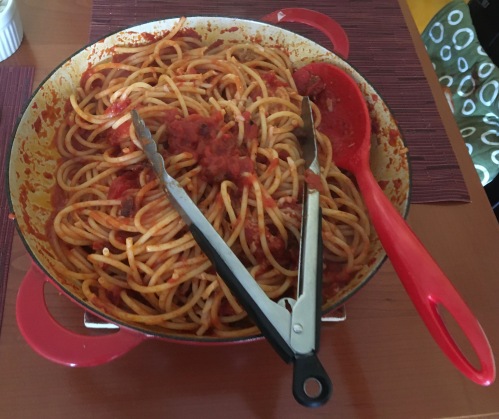 Pasta Amatrciana, my favorite with bucatini.
Pasta Amatrciana, my favorite with bucatini. On the plate, messy but so good.
On the plate, messy but so good. Montepulciano D’ Abruzzo 1985 Emidio Pepe100% Montepulciano D’Abruzzo. The winery is organic and Bio-Dynamic. They belong to the Triple “A” Agriculture Artisans Artists. Both the tendone method and the cordon spur method are used for training the vines. In vintages when the weather is very hot the tendone method is better because the leaves form a canopy to protect the grapes from the sun. When the weather is not too hot, the cordon spur is better because it allows more sun and air to reach the grapes. One hectare of tendone has 900 vines and produces 90 quintals of grapes. That means that each vine produces from 6 to 9 kilos of grapes. In one hectare of cordon spur trained grapes, there are 3,300 vines and each vine produces 5 to 6 kilos of grapes. The grapes are crushed by hand and the juice placed in glass-lined cement tanks of 20/25 liters. Only natural yeasts are used, there is no filtration or fining. The wine is transferred to the bottle by hand and the corks are placed in the bottles by hand. This is a very impressive wine with deep red fruit aromas and flavors with hints of cherry, spice and leather.
Montepulciano D’ Abruzzo 1985 Emidio Pepe100% Montepulciano D’Abruzzo. The winery is organic and Bio-Dynamic. They belong to the Triple “A” Agriculture Artisans Artists. Both the tendone method and the cordon spur method are used for training the vines. In vintages when the weather is very hot the tendone method is better because the leaves form a canopy to protect the grapes from the sun. When the weather is not too hot, the cordon spur is better because it allows more sun and air to reach the grapes. One hectare of tendone has 900 vines and produces 90 quintals of grapes. That means that each vine produces from 6 to 9 kilos of grapes. In one hectare of cordon spur trained grapes, there are 3,300 vines and each vine produces 5 to 6 kilos of grapes. The grapes are crushed by hand and the juice placed in glass-lined cement tanks of 20/25 liters. Only natural yeasts are used, there is no filtration or fining. The wine is transferred to the bottle by hand and the corks are placed in the bottles by hand. This is a very impressive wine with deep red fruit aromas and flavors with hints of cherry, spice and leather. Fried lamb chops, also from Michele’s book. The chops are coated with eggs, Parmigiano Reggiano and plain dry breadcrumbs. Here she used panko, which fries up nice and crunchy. Sorry for the photo, but we all grabbed some chops and started to eat before I could get a better shot!
Fried lamb chops, also from Michele’s book. The chops are coated with eggs, Parmigiano Reggiano and plain dry breadcrumbs. Here she used panko, which fries up nice and crunchy. Sorry for the photo, but we all grabbed some chops and started to eat before I could get a better shot! Dante’s Cheesecake is Michele’s version of a ricotta cheesecake that we used to enjoy at a favorite Greenwich Village Cafe.
Dante’s Cheesecake is Michele’s version of a ricotta cheesecake that we used to enjoy at a favorite Greenwich Village Cafe.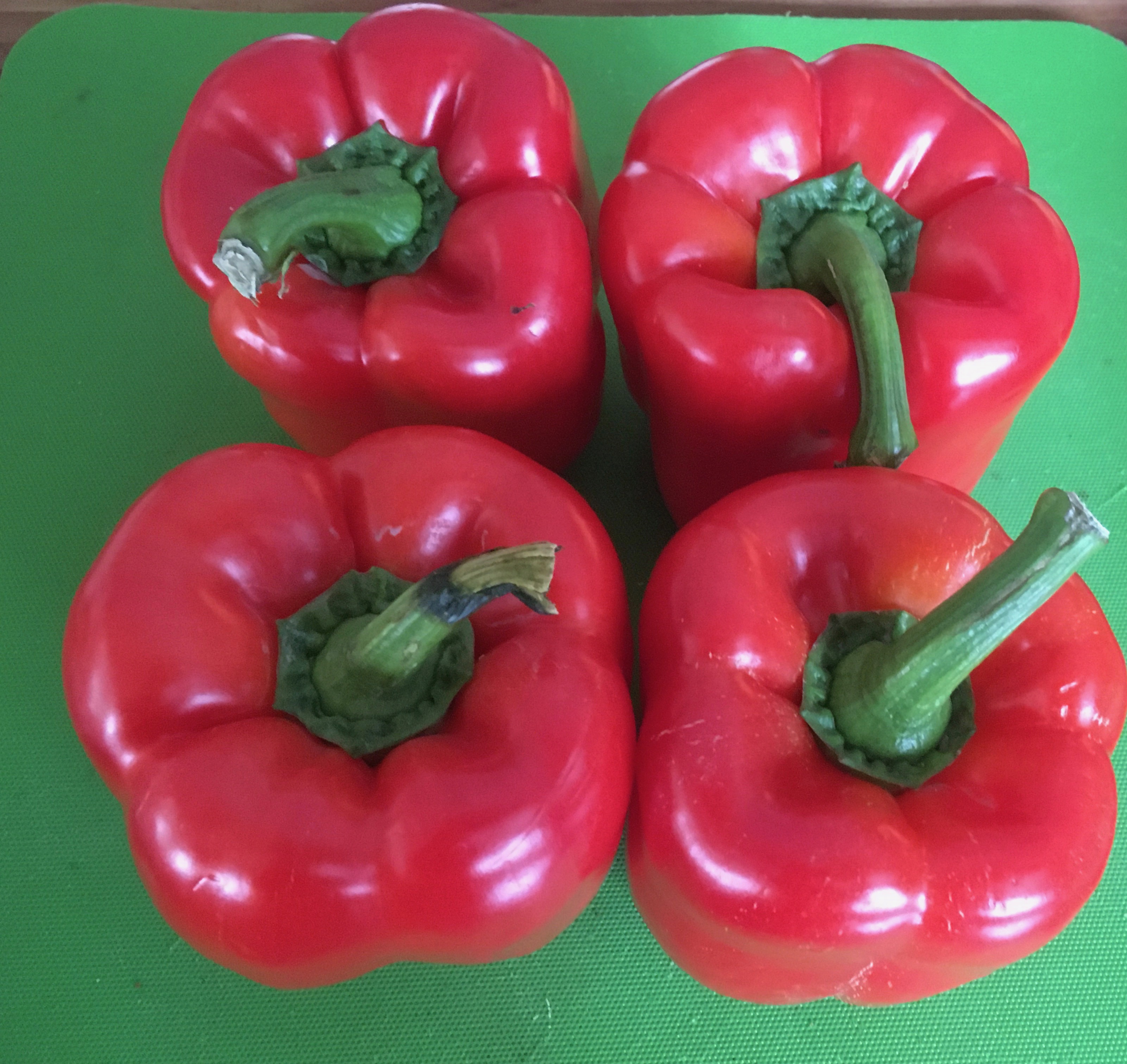 First, we had a little antipasto of marinated roasted red peppers. Here are the peppers ready to be cut
First, we had a little antipasto of marinated roasted red peppers. Here are the peppers ready to be cut After roasting and peeling, Michele marinated them with thick slices of garlic, olive oil and oregano. She leaves the garlic in large pieces so that it is easy to remove them. We ate the peppers with anchovies.
After roasting and peeling, Michele marinated them with thick slices of garlic, olive oil and oregano. She leaves the garlic in large pieces so that it is easy to remove them. We ate the peppers with anchovies. To go with the meatloaf, Michele made sauteed zucchini and onions with cherry tomatoes. She used canned cherry tomatoes. The secret of this recipe is to cook it just to the point where the zucchini are still firm and not mushy.
To go with the meatloaf, Michele made sauteed zucchini and onions with cherry tomatoes. She used canned cherry tomatoes. The secret of this recipe is to cook it just to the point where the zucchini are still firm and not mushy. The saucy vegetables were a nice complement to the meatloaf.
The saucy vegetables were a nice complement to the meatloaf. The meatloaf, called polpettone, is made mostly with beef, and some veal and pork ready mixed with chopped prosciutto, salami and cheese. Here it is ready for the oven
The meatloaf, called polpettone, is made mostly with beef, and some veal and pork ready mixed with chopped prosciutto, salami and cheese. Here it is ready for the oven The meatloaf out of the oven
The meatloaf out of the oven On the plate, the meatloaf was moist and full of flavor, complemented by the sauteed zucchini.
On the plate, the meatloaf was moist and full of flavor, complemented by the sauteed zucchini. Montepulciano D’ Abruzzo 2003 Emidio Pepe100% Montepulciano D’Abruzzo. The winery is organic and Bio-Dynamic. They belong to the Triple “A” Agriculture Artisans Artists. Both the tendone method and the cordon spur method are used for training the vines. In vintages when the weather is very hot the tendone method is better because the leaves form a canopy to protect the grapes from the sun. When the weather is not too hot, the cordon spur is better because it allows more sun and air to reach the grapes. One hectare of tendone has 900 vines and produces 90 quintals of grapes. That means that each vine produces from 6 to 9 kilos of grapes. In one hectare of cordon spur trained grapes, there are 3,300 vines and each vine produces 5 to 6 kilos of grapes. The grapes are crushed by hand and the juice placed in glass-lined cement tanks of 20/25 liters. Only natural yeasts are used, there is no filtration or fining. The wine is transferred to the bottle by hand and the corks are placed in the bottles by hand. This is a very impressive wine with deep red fruit aromas and flavors with hints of cherry, spice and leather. It is still young and will last for many years.
Montepulciano D’ Abruzzo 2003 Emidio Pepe100% Montepulciano D’Abruzzo. The winery is organic and Bio-Dynamic. They belong to the Triple “A” Agriculture Artisans Artists. Both the tendone method and the cordon spur method are used for training the vines. In vintages when the weather is very hot the tendone method is better because the leaves form a canopy to protect the grapes from the sun. When the weather is not too hot, the cordon spur is better because it allows more sun and air to reach the grapes. One hectare of tendone has 900 vines and produces 90 quintals of grapes. That means that each vine produces from 6 to 9 kilos of grapes. In one hectare of cordon spur trained grapes, there are 3,300 vines and each vine produces 5 to 6 kilos of grapes. The grapes are crushed by hand and the juice placed in glass-lined cement tanks of 20/25 liters. Only natural yeasts are used, there is no filtration or fining. The wine is transferred to the bottle by hand and the corks are placed in the bottles by hand. This is a very impressive wine with deep red fruit aromas and flavors with hints of cherry, spice and leather. It is still young and will last for many years.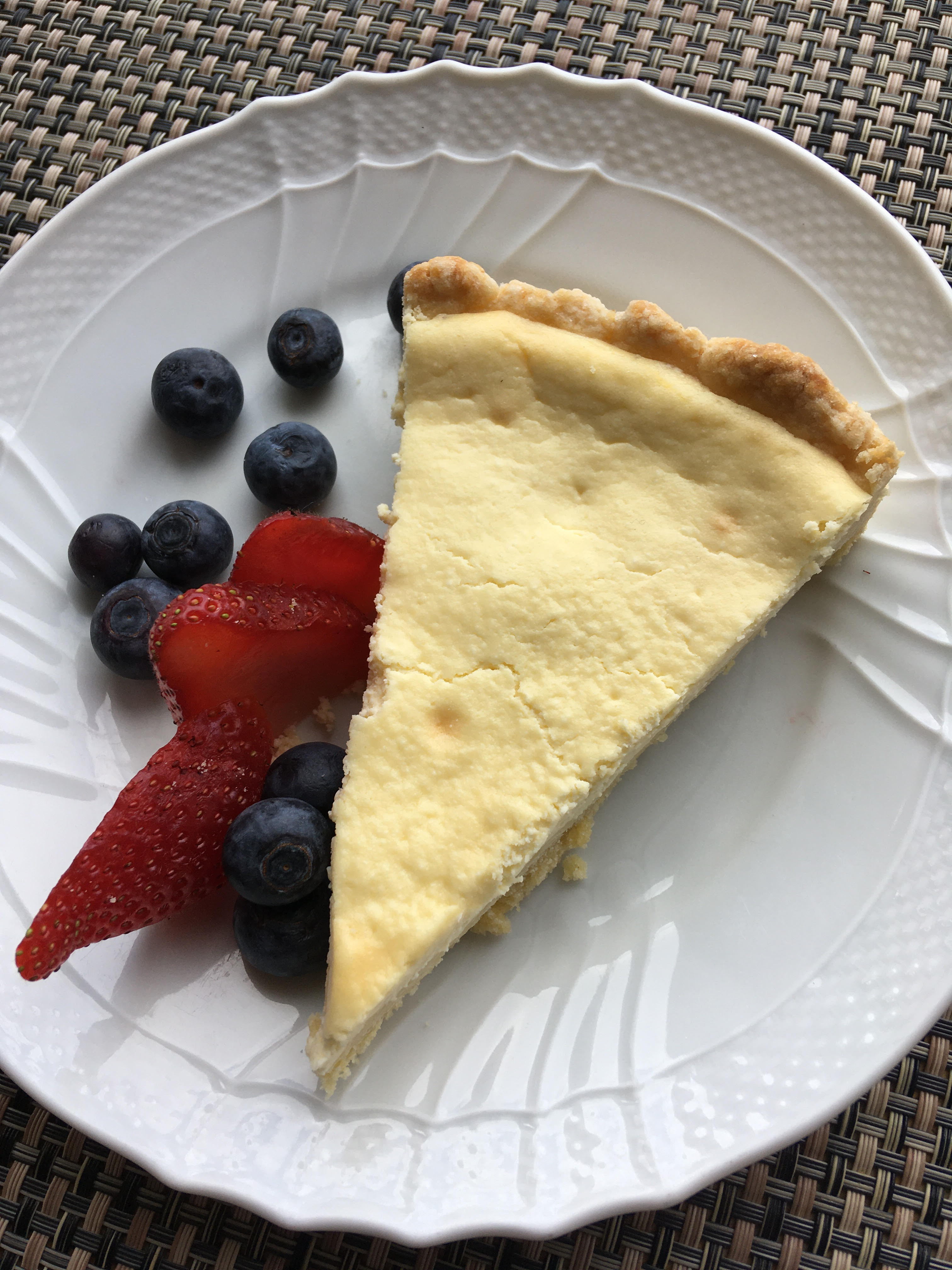 For Dessert, we had a Roman style cheesecake. The recipe is from Michele’s dessert book, La Dolce Vita.
For Dessert, we had a Roman style cheesecake. The recipe is from Michele’s dessert book, La Dolce Vita. 














